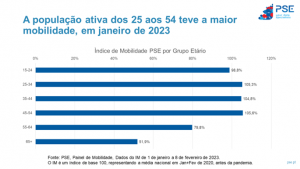Mobility in January 2023 was only 3.6% higher than before the pandemic
PSE Mobility Panel allows knowing the behavior of the population in relation to the mobility movements it makes, in the geographic universe that we study in Portugal.
PSE mobility index has a base of 100, where 100 represents the average mobility existing in January and February 2020, that is, a period prior to the pandemic. The value of the PSE mobility index for January 2023 is 103.6, which means that there is only a growth of 3.6 percentage points, compared to the pre-pandemic reality.
This result of mobility results from the normalization of activities, on the one hand, but on the other hand it is also the result of the introduction of greater flexibility of movements of the population as a result of hybrid work, that is, telecommuting combined with presence in the workplace. This phenomenon is important only in the AM Lisbon and in the AM in Porto, where the latest PSE information points to around 16% of the active population working from home or on a hybrid basis.
A curious fact, if we look at mobility by gender, we conclude that men move 7.9 percentage points more than women, in terms of the number of kilometers, on a monthly average. These data refer only to private mobility and movements made in professional mobility, namely transport and logistics, are not studied here. In terms of age, it is above all the active population that showed the greatest mobility in January, as is usual in every month. Here we can see the level of mobility by age groups:
INTRODUCTION:
This study produces, in addition to monitoring mobility, information on the outdoor advertising audience, since it is the study accredited by CAEM, for Portugal, since 2020.
TECHNICAL NOTE:
This study is the PSE panel, with continuous data collection through location monitoring and means of travel via mobile application of a panel of 3000 individuals representing the Universe aged over 15 years, residing in the regions of Greater Porto, Greater Lisbon, North Coast, Center Coast and District of Faro. This study involves an APP installed on the participating sample’s mobile phones. In this way, we monitor the actual displacement of the population, at every hour of the day. This study is conducted 24 hours a day. Data are obtained rigorously, via GPS and with the consent of the monitored sample. For a universe of 6,996,113 individuals residing in the regions studied, the margin of error attributable to the study is 1.62% for a 95% confidence interval.




